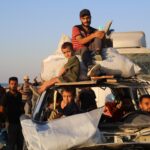
Israeli forces killed at least 36 Palestinians on Tuesday as they pounded Gaza from the air and ground, as world leaders at the United Nations General Assembly (UNGA) in New York demanded an end to the two-year war.
Residential buildings continue to be flattened as Israel presses ahead with its plan to seize the enclave’s largest city.
- list 1 of 4‘Rogue state’: Qatar’s emir condemns Israel’s conduct in Gaza
- list 2 of 4Israel seeks permanent Gaza control, Jewish majority in West Bank: UN
- list 3 of 4South Africa: Israel’s genocide must stop
- list 4 of 4What are the risks of a global digital divide in AI?
end of list
Satellite imagery analysed by Al Jazeera shows Israeli army vehicles tightening a stranglehold around Gaza City, surrounding it from several directions. Footage verified by Al Jazeera shows tanks pushing into the Nassr neighbourhood, barely a kilometre from al-Shifa Hospital.
This destruction forms part of a pattern that a UN commission says amounts to genocide.
The Office of the UN High Commissioner for Human Rights (OHCHR) on Tuesday warned that Israel’s military actions are “inflicting terror on the Palestinian population of Gaza City and forcing tens of thousands to flee”.
The suffering of Palestinians has drawn the attention of the global leaders, who have used the UNGA platform to demand a ceasefire in Gaza.
Addressing the UNGA, US President Donald Trump said that the Gaza war should stop “immediately” but dismissed the recognition of a Palestinian state by several Western countries, calling it a “reward” for Hamas.
The US president met leaders from Saudi Arabia, Qatar, the UAE, Egypt, Jordan, Turkiye, Indonesia and Pakistan on the sidelines of the UNGA. Turkish President Tayyip Erdogan said the meeting was “very fruitful,” adding that a joint declaration from the meeting would be published.
Advertisement
‘Stuck under the rubble’
Israeli strikes have hit civilians across Gaza. One man was killed and others wounded in the Tal al-Hawa neighbourhood, while another strike hit Palestinians queueing for water in Gaza City’s Daraj neighbourhood, sources told Al Jazeera.
Medical infrastructure is also being dismantled. Israeli shelling destroyed the main medical centre in Gaza City, injuring at least two medical workers, according to the Palestinian Medical Relief Society.
The charity said that troops prevented the evacuation of equipment and supplies, even as the facility served the wounded, cancer patients and blood donors. Other clinics in Tal al-Hawa and the Shati refugee camp have also been destroyed or besieged.
Hind Khoudary, reporting for Al Jazeera from az-Zawayda, described the devastation: “The situation continues to deteriorate, especially in the heart of Gaza City, where Israeli forces have been using artillery shelling and quadcopters to push more Palestinians to evacuate to the south and central areas.
“There have been endless appeals from Palestinian families saying their relatives are stuck under the rubble, but no one can reach them.”
No safe zones
Tens of thousands of Palestinians fleeing Gaza City have ended up in the central and southern areas of the enclave, which are under constant bombardment. The Israeli-designated “safe zone” of al-Mawasi has itself been attacked repeatedly, with health officials warning that it lacks the basic necessities of life, including water, food [and] health services, while disease spreads through overcrowded camps.
Experts say the forced movement is itself part of the machinery of genocide: driving families into displacement under fire and stripping them of shelter, food and dignity.
At Nasser Medical Complex in Khan Younis, doctors report that three Palestinians were shot and killed by Israeli forces near the supposed safe zone further south. Three children died from malnutrition in southern Gaza, according to hospital sources.
In August, the Integrated Food Security Phase Classification declared that famine was under way in northern Gaza and would spread south. Gaza’s Ministry of Health warns that hospitals are now “entering an extremely dangerous phase” due to fuel shortages.
This collapse of health services and the deliberate obstruction of food and fuel deliveries has led to UN experts accusing Israel of using starvation as a weapon of war.
West Bank under attack
While global attention remains fixed on the destruction in Gaza, events in the occupied West Bank may carry even deeper implications for the future of the conflict.
Advertisement
Israel has threatened to accelerate annexation plans in the West Bank in the wake of recognition of Palestinian statehood by several Western countries, including France and the United Kingdom.
On the ground, violence has intensified. Armed settlers shot dead Saeed Murad al-Nasan in the village of al-Mughayyir, north of Ramallah, Al Jazeera Arabic reported.
Israeli forces raided multiple towns around Nablus and ordered the indefinite closure of the King Hussein (Allenby) Bridge, the only gateway for goods and people between the West Bank and Jordan.
The tightening of settlements, killings and closure of borders are not isolated incidents. Together, they form part of what a UN report on Tuesday described as a systematic effort to secure permanent Israeli control over Gaza and entrench a Jewish majority in the West Bank.
It comes after a UN commission concluded last week that Israel’s policies – forced displacement, denial of return, destruction of infrastructure and the deliberate use of starvation as a weapon – meet the legal definition of genocide.
British Caribbean News

